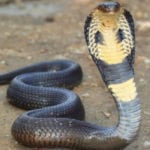 Technology
Technology  Technology
Technology  Humans
Humans 10 Everyday Human Behaviors That Are Actually Survival Instincts
 Animals
Animals 10 Animals That Humiliated and Harmed Historical Leaders
 History
History 10 Most Influential Protests in Modern History
 Creepy
Creepy 10 More Representations of Death from Myth, Legend, and Folktale
 Technology
Technology 10 Scientific Breakthroughs of 2025 That’ll Change Everything
 Our World
Our World 10 Ways Icelandic Culture Makes Other Countries Look Boring
 Misconceptions
Misconceptions 10 Common Misconceptions About the Victorian Era
 Mysteries
Mysteries 10 Strange Unexplained Mysteries of 2025
 Miscellaneous
Miscellaneous 10 of History’s Most Bell-Ringing Finishing Moves
 Technology
Technology Top 10 Everyday Tech Buzzwords That Hide a Darker Past
 Humans
Humans 10 Everyday Human Behaviors That Are Actually Survival Instincts
 Animals
Animals 10 Animals That Humiliated and Harmed Historical Leaders
Who's Behind Listverse?

Jamie Frater
Head Editor
Jamie founded Listverse due to an insatiable desire to share fascinating, obscure, and bizarre facts. He has been a guest speaker on numerous national radio and television stations and is a five time published author.
More About Us History
History 10 Most Influential Protests in Modern History
 Creepy
Creepy 10 More Representations of Death from Myth, Legend, and Folktale
 Technology
Technology 10 Scientific Breakthroughs of 2025 That’ll Change Everything
 Our World
Our World 10 Ways Icelandic Culture Makes Other Countries Look Boring
 Misconceptions
Misconceptions 10 Common Misconceptions About the Victorian Era
 Mysteries
Mysteries 10 Strange Unexplained Mysteries of 2025
 Miscellaneous
Miscellaneous 10 of History’s Most Bell-Ringing Finishing Moves
10 Shockingly Small But Adorable Aquatic Creatures
With water covering over 70 percent of the Earth, the contents and inhabitants of our oceans, rivers, and lakes can be mysterious. Many large creatures living in the ocean or in fresh water have become popular with the public and are even featured on various television shows.
However, small aquatic creatures are not as well-known despite being just as abundant. It is difficult to believe that these tiny sea creatures can survive the treacherous depths of oceans and the huge variety of predators. Against all odds, the shockingly small aquatic creatures below not only survive but thrive—all while being incredibly adorable.
10 Nudibranchs
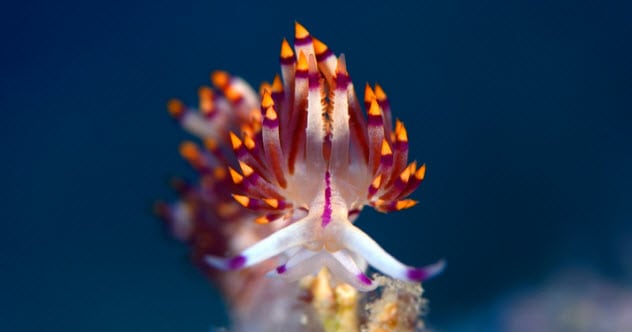
The nudibranch is a shell-less mollusk that can be as small as 0.64 centimeters (0.25 in). While pictures commonly show the nudibranch as a colorful and brightly patterned feathery creature, they can vary in size, shape, and color depending on the specific environment in which they live. Nudibranchs, which can live up to one year, are most often found in shallow, tropical waters, although they also inhabit our oceans.[1]
These tiny creatures are hermaphrodites (simultaneously male and female), which gives them the ability to mate with any other mature nudibranch. They are also carnivores that feed on a variety of creatures, including other nudibranchs.
In some places around the world, like Chile, nudibranchs are part of local diets. They can be boiled or eaten raw, though we can’t comment on the taste.
9 Pygmy Seahorses (Hippocampus bargibanti)
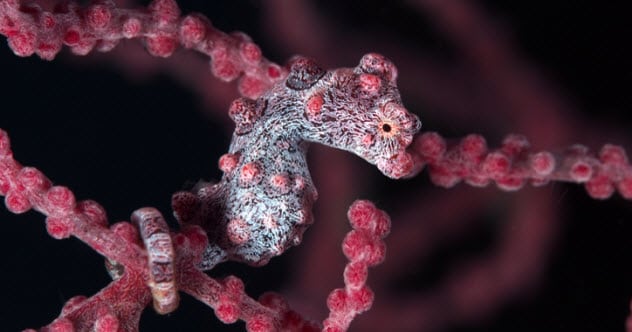
The tiny seahorse Hippocampus bargibanti, one of the smallest in the world, is a relatively new discovery for scientists. Researchers found these microscopic seahorses accidentally when examining the coral reefs of the western Pacific Ocean and have been studying them ever since. So far, researchers have learned that the creatures have an average length of 1–2 centimeters (0.4–0.8 in), and more is being discovered about their behaviors and natural habitats.
The usually yellow or orange pygmy seahorse uses coral reefs as camouflage to survive among the dangerous, predator-filled ocean. Their small size and lack of a digestive system leads to their diet of young brine shrimp and other tiny crustaceans for sustenance.
Much like other seahorses, the male becomes pregnant and gives birth to offspring after brooding young within his trunk. The creatures are also known to be monogamous throughout their short life span.[2]
8 Whip Coral Shrimp (Dasycaris zanzibarica)
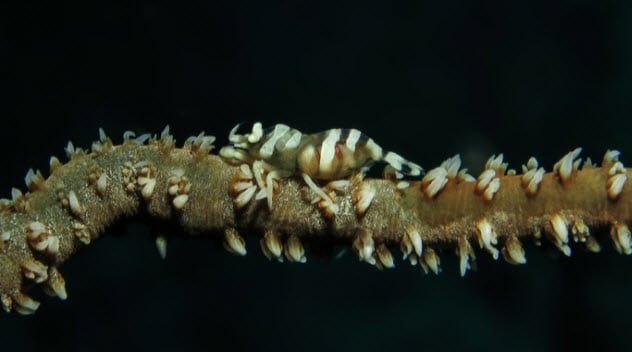
The whip coral shrimp (aka carid shrimp or commensal shrimp) are only about 1.5 centimeters (0.6 in) in length. This is much smaller than the average size of shrimp, which range from about 4–8 centimeters (1.6–3.1 in) long. The whip coral shrimp have light colors that are commonly red and white with the majority of their bodies covered in interesting-looking spines.
As their name suggests, these textured shrimp live among whip coral for camouflage at depths of 210 meters (690 ft) to only 10 meters (33 ft). The coral is very important to the shrimp. They also use it as a food source for the tiny plankton that live in and around the coral. Additionally, the shrimp can feed off algae and even parasites that would normally damage the coral, making the relationship symbiotic (mutually beneficial).[3]
7 Dwarf Lanternshark (Etmopterus perryi)
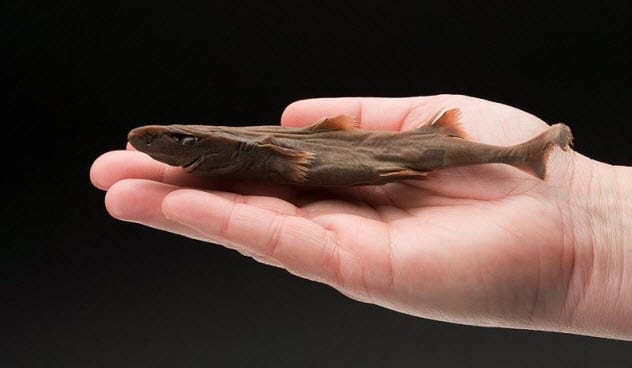
The smallest shark in the world, the dwarf lanternshark, only grows to about 20 centimeters (8 in) long at full maturity. Not much is known about this shark as it was just discovered in 1964 and is rarely seen.
However, it is known that the dwarf lanternshark only lives in the Caribbean Sea near the South American coastline at depths of 300–460 meters (1,000–1,500 ft). These sharks are dark brown and can also have black markings along their bodies as well as thin scales called dermal denticles.
Despite its small size, the dwarf lanternshark is a carnivore, mainly feeding on krill and other small crustaceans. Like other lanternsharks, the dwarf lanternshark is bioluminescent, meaning it possesses an organ that creates light organically.
The exact life span of this shark is unknown. However, it is thought to be relatively short due to the large number of predators and parasites that are known to attack the shark.[4]
6 Sea Urchin (Echinocyamus scaber)
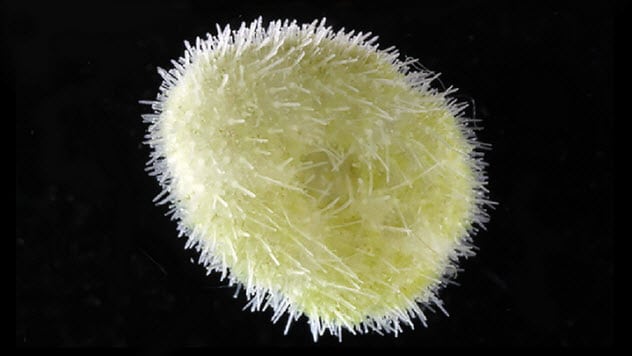
Echinocyamus scaber, the smallest sea urchin, only measures 6 millimeters (0.2 in) across and is commonly found in the western central Pacific Ocean. These creatures resemble small, spine-covered, fuzzy balls that often live underneath the sand or within small crevices of rocks underwater. Their color depends on the specific environment in which they live.[5]
Although this species is extremely small, this sea urchin has similar behaviors to that of larger species like it. Sea urchins have a water vascular system that allows for movement through muscle contractions and the creation of water pressure. Sea urchins are also foragers and prefer to eat algae, seagrasses, and seaweeds at night to avoid predators and other dangers.
5 Dwarf Pygmy Goby (Pandaka pygmaea)
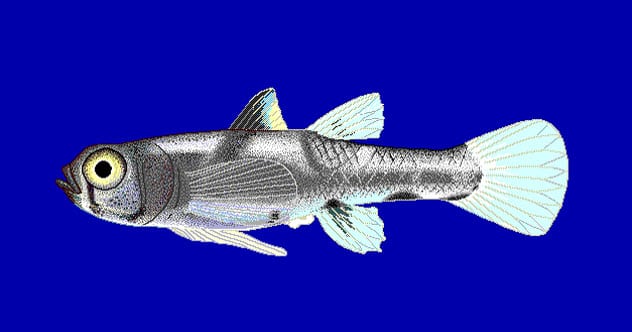
Dwarf pygmy gobies are extremely small fish that are less than 9 millimeters (0.4 in) at maturity. They were originally thought to only live within the fresh water of the Philippines. However, they have been discovered recently within the waters of other regions such as Singapore, Bali, and Fiji. The dwarf pygmy goby lives mostly in muddy and shady water at a depth of no more than 2 meters (6.6 ft) with plenty of aquatic plants to use for camouflage.[6]
These fish have bodies that are almost completely transparent with four black cross bands to mimic shadows. They also have a small number of scales. The fish mainly live on plankton found within the waters of their environment. However, they have been known to feed on other forms of aquatic plants, if necessary.
4 Pea Crab (Pinnixa faba)
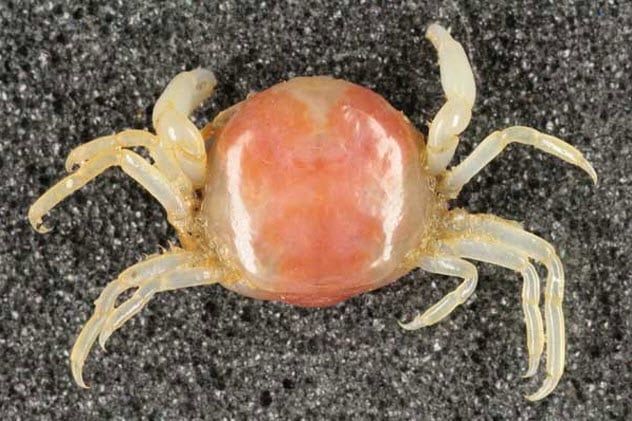
The pea crab gets its name from its small size and circular shape, which resembles a pea. This animal is the smallest crab in the world as the male only grows to less than 0.8 centimeters (0.3 in) at maturity. Female pea crabs are usually light pink in color, while the males are dark brown.
Some people classify pea crabs as parasites because they prefer to live within mollusks, using them for safety and a source of food. However, rather than feed on the mollusks themselves, the pea crabs feed on various foods ingested by the mollusks. As a result, other people classify the pea crab as a “commensal.”
Sometimes, pea crabs are also known as oyster crabs because they are commonly found in oysters caught off the Atlantic coastal waters and the Chesapeake Bay.[7]
3 Paddle-Spined Sea Star (Patiriella parvivipara)
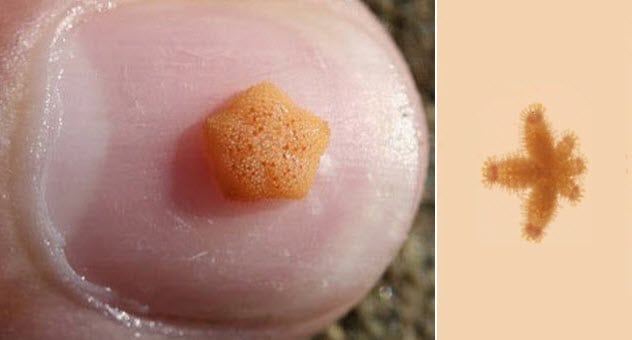
The paddle-spined sea star, the smallest sea star in the world, only grows to about the size of a fingernail. First discovered in 2007, this animal is yellow to orange in color and lives with other small sea creatures in shallow pools along the coast of southern Australia.
Like other sea stars, the paddle-spined sea star does not have bones and is classified in the large group of echinoderms. In fact, a starfish (the old name for a sea star) is actually not a fish at all. It is more closely related to sea urchins.
Although this creature can have the traditional five arms seen in other types of sea stars, the paddle-spined sea star typically has six arms, which is unusual in a sea star this small. As the name suggests, the arms are lined with paddle-like spines. These creatures also have a very unusual life cycle in that adults self-fertilize and offspring go on to have an abnormal growth cycle.[8]
2 Star-Sucker Pygmy Octopus (Octopus wolfi)
Many videos of this tiny octopus are becoming popular—not only to show its small size but also its curious behavior. The star-sucker pygmy octopus only weighs about 28 grams (1 oz) and measures about 13 centimeters (5 in) in length overall, including its tentacle length of 8 centimeters (3 in).
These small creatures are commonly found in the warm and clean water of the Cayman Islands. However, they are great at hiding and blending into different objects.[9]
To compensate for its size, this carnivorous pygmy octopus possesses venom that is injected into prey before it is eaten. Although these creatures enjoy chowing down on crustaceans, individual octopuses have been observed to be picky eaters. These animals are also very playful and are known to be smart, making them amusing to observe from a distance.
1 Paedocypris progenetica
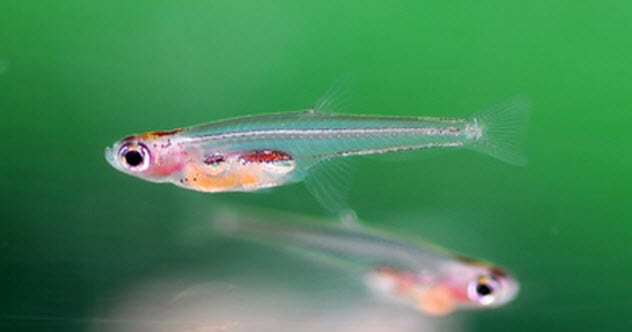
Paedocypris progenetica, the world’s smallest fish, is a mere 7.9 millimeters (0.3 in) long. It was discovered in 2006 by researchers Maurice Kottelat and Tan Heok Hui within the swamps of the Indonesian island of Sumatra. There, the water was dark and acidic, with a pH measuring almost 100 times more acidic than rainwater.
It was originally thought that these waters were largely uninhabitable. However, researchers are discovering an increasing number of species that can survive within these extreme conditions.
Paedocypris progenetica has a mostly transparent body with a head that is not protected by a skeleton.[10] Despite their small size, the male fish have pelvic fins that are capable of grasping, which probably helps during mating. The life span of these tiny fish is unknown. However, researchers are studying these creatures in detail to learn more about them.
Jordan is a college graduate who is passionate about almost everything (especially writing).
Read more amazing stories about aquatic creatures on 10 Legends Of Aquatic Humanoid Creatures and 10 Otherworldly Sea Creatures You’ve Never Heard Of.





